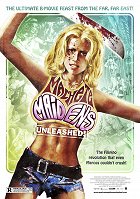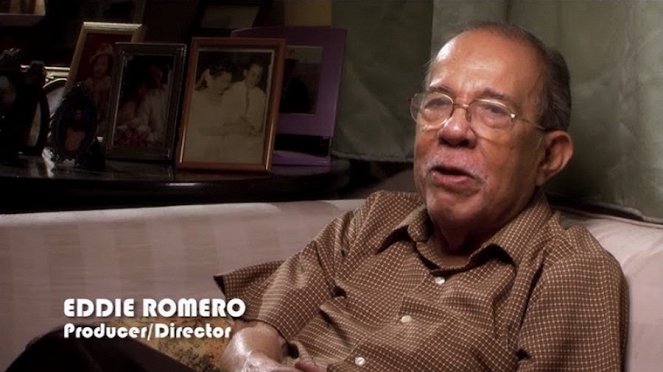Directed by:
Mark HartleyScreenplay:
Mark HartleyCinematography:
Karl von MollerComposer:
Jamie BlanksCast:
Roger Corman, John Landis, Allan Arkush, Joe Dante, Dick Miller, Jonathan Kaplan, R. Lee Ermey, Sid Haig, Jack Hill, Jonathan Demme, Colleen Camp, Steve Carver (more)Plots(1)
In the 1960s and 70s, drive-in movie theaters and big city grindhouses were eager to book the wildest and most action-packed fare they could find, and low-budget producers were always on the lookout for something unique to offer their viewers. Many of them found it in the Philippines, a country full of exotic locations, cooperative officials and folks willing to work cheap. Local producer Eddie Romero began exporting his cut-rate horror and crime pictures to American distributors in the 60s, and before long U.S. filmmakers were traveling there to shoot crazed jungle epics, women in prison thrillers, bloody horror stories and violent wartime dramas. It certainly helped that Philippine extras and technicians would work hard for low pay, and that local stuntmen didn't seem to worry much about risking their necks for a good shot; as one producer put it, "Human life was cheap, film was cheap -- it was a great place to shoot a movie!" Filmmaker Mark Hartley, who shared the crazed true story of the Australian exploitation movie scene in his documentary Not Quite Hollywood, shares the inside scoop on the wild and wooly world of filmmaking in the Philippines in the 1960s and 70s in Machete Maidens Unleashed! (official distributor synopsis)
(more)Reviews (2)
“YOU CAN´T RAPE ME! I LOVE SEX!“, or, as Roger Corman said: "It's all about asses, tits and action." Yeah, the late 1960s and '70s were a blast in the Philippines. The country was grateful to the Americans for its liberation from Japanese rule, and Hollywood filmmakers felt they could make worthwhile films there. You have a jungle, you have beaches, you have girls, you have guns and everything is cheap! This documentary focuses mostly on the story of the production company New World, which set up shop there, joined forces with local talented (although that may be a strong word) filmmakers and it was a roller coaster ride. Their films were then marketed to the world not as "Filipino movies" but as "jungle action movies". It all started with Gerardo de Leon and especially Eddie Romero, two Filipino director legends who under the motto "What sells best? The 3 Bs! Blood, Breasts and Beasts!“, began producing cheap, obscure exploitation B-movies. It started with Terror Is a Man, which was followed by such gems as Brides of Blood , Beast of Blood , Mad Doctor of Blood Island, etc. etc., all under the directorial supervision of Romero in particular. At the beginning of the 1970s, Roger Corman came in as a producer, joining forces mainly with Romero, and after his film about naughty nurses was a commercial success, he got the idea for a film about women in a prison camp, with nude shower scenes, some torture, lesbian sex, etc, and produced The Big Doll House, which enjoyed great success and gave birth to the women in prison genre, and it was followed by, among others Women in Cages, The Big Bird Cage. They introduced a new star, Pam Grier, who’s still admired by Tarantino to this day (she starred in Jackie Brown) and who was aptly described by her acting colleague Sid Haig as: "She had everything the audience loved. She had sparkle, was good looking, had big tits and was smart." The women in prison films were replaced by action films, backed by another legend, Cirio H. Santiago, and his TNT Jackson, which, following the popularity of blaxploitation films and their all-black actors, featured a kung-fu black woman in the lead role, while the massively successful Firecracker featured a kung-fu white woman, Fly Me featured a kung-fu stewardess, etc. Tarantino himself has admitted several times that Santiago was a source of inspiration. It also mentions the obscure Filipino star Weng-Weng, a dwarf who plays Agent 000 in the serious-minded "Bond-like" movies, where he spouts kung fu from his little body, flies in a hovercraft, uses an umbrella instead of a parachute and slaps beautiful models. There is also mention of Corman's films, as a response to the huge success of Spielberg's Jaws, such as Up from the Depths, with a ridiculous-looking deadly shark, as well as The Twilight People, where the main character is The Bat Man - a Filipino with bat wings, who was supposed to draw Batman fans to the cinemas. Dictator Ferdinand Marcos, who was open to the filmmakers, also gets a mention, with the most piquant reference being how Coppola, whose famous Apocalypse Now was also filmed in the Philippines, borrowed helicopters for the film, which had actually killed rebels in the south of the country shortly before the scene of the bombing of the Vietnamese village. The documentary ends by mentioning why they stopped filming in the Philippines (because of Muslim extremists in the south, banks didn't want to insure film shoots) and most importantly, Star Wars changed everything, Its release in 1977 changed audiences’ tastes, who now demanded big-budget special effects films, and grindhouse cinemas began to disappear, bringing the end of low-budget films in cinemas, which moved mainly to VHS, when even the Philippines became expensive.
()
(less)
(more)
The film "Girls with Machetes Attack!" is a great documentary that focuses on a large number of films, a large number of personalities, and presents pieces that I simply want to see. Yes, they are twisted, disgusting, and stupid pieces, but that's what makes them beautiful. Mart Hartley presents everything with love for the genre and for all these films. Maybe we will see the B-movies generally deserve more recognition.
()

